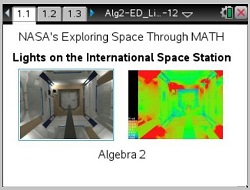Lights on the International Space Station

Lights on the International Space Station
In this lesson, students will discover how various factors affect lighting by using different types of flashlights and battery strenghts.
In this lesson, students will use the 5-E's Instructional Model - Engage, Explore, Explain, Extend, and Evaluate.
As a result, students will:
- analyze data from a simulation
- model data from a simulation using a graphical and algebraic approach
- apply the measure of illumination, lux=candela m2, to various situations
- scatter plots
- modeling functions
- applying formulas
- inverse variation
- power functions
Here on Earth, the sense of sight and the benefits of illumination can easily be taken for granted. While astronauts orbit the Earth, the sun rises and sets approximately every forty-five minutes, causing humans to cope with dynamic lighting conditions. Since contrast conditions of harsh shadowing and glare are also severe, the optimization of lighting conditions is essential for critical operations. The Lighting Environment Test Facility (LETF), located at NASA Johnson Space Center in Houston, Texas, investigates and evaluates proposed lighting systems for use on space vehicles. Lighting systems enhance the www.nasa.gov Lights on the International Space Station 1/12
crews' direct and indirect viewing ability during spaceflight.
This effort includes the investigation, measurement, and analysis of:
- artificial lighting systems, such as docking lights, portable lights, and navigation lights;
- reflective characteristics of various materials and the effects of solar lighting;
- transmission characteristics of transparent materials used for visors, displays and windows
- camera performance for minimum and maximum illumination
Vernier EasyData,Vernier EasyLink and Vernier EasyTemp are registered trademarks of Vernier Science Education.

